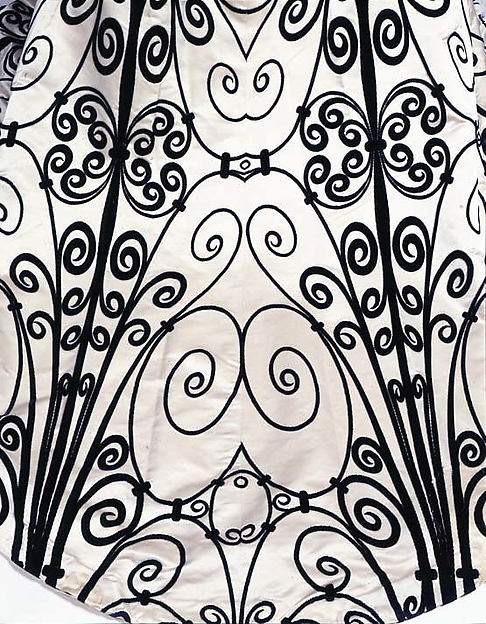This is a bit of a continuation on the theme of stripes I wrote about on Friday, with curliques.
I'm going to begin with my effusive thanks to the Met for saving this unique garment. It is without question one of the most important designs ever to have been produced by the Worth couture house. Its a sublime combination of the highest levels of the weavers art, and the perfection of the assembly skills of the workers in the Worth atelier.
Of course everything depends on the boldly scaled black and white pattern of the fabric. This is not embroidery. The pattern was woven en disposition, to be assembled exactly as you see it here. The ground is pale cream silk satin, and the elaborate scrollwork design is velvet pile. The house was long known for the high drama, and huge scale of the textiles it favored, but this is the most dramatic they ever utilized. Think for a moment about the precision required of the weavers, who had to create the pattern not only to shape, but to size to make this happen as it does. The level of skill is off the chart high.
The ultimate success of this design lies in three things. First, the positioning of the pattern over the body maximizes the ability of stripes to shape the form, and fool the eye. We see the waist as being smaller than it is, the shoulder and hip lines, broader. The lines also create a strong sense of movement, causing the eye to race over the shape towards the top, almost like being propelled in that direction. The second reason is the absolute perfection of how the individual pattern pieces have been joined. Nothing interrupts the flow of those lines, giving the whole construction a grace that is undeniable. And finally, the near absence of any other decorative details allows the strength of this graphic presentation to really sing. There is a shallow ruched gather of the fabric at the neckline, and short gathered silk tulle sleeves with black velvet bows. That's all.
Its interesting to me to look at this for another reason. Though this design conforms to the sense of drama the house was known for, it is absolutely not the work of Charles Frederick Worth, who liked a good deal more decorative detailing than this gown has. Its definitely the work of his son Jean Phillipe, with a fresher, more modern approach.
There are to my mind, few examples of the potency of line to convey motion, form, and volume that equal this.






Remarkable! I've seen this gown many times, but always assumed the pattern was embroidery or appliqué. That the pattern is woven in, and then the way it's been used...? Quite the feat of dressmaking. : )
ReplyDeleteHonestly I get a headache thinking of how much math went into figuring out exactly how to weave the material en disposition. we no longer see this level of work, even in the couture.
Delete